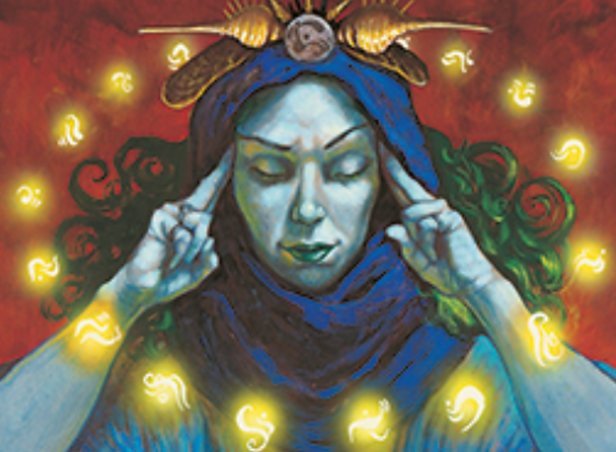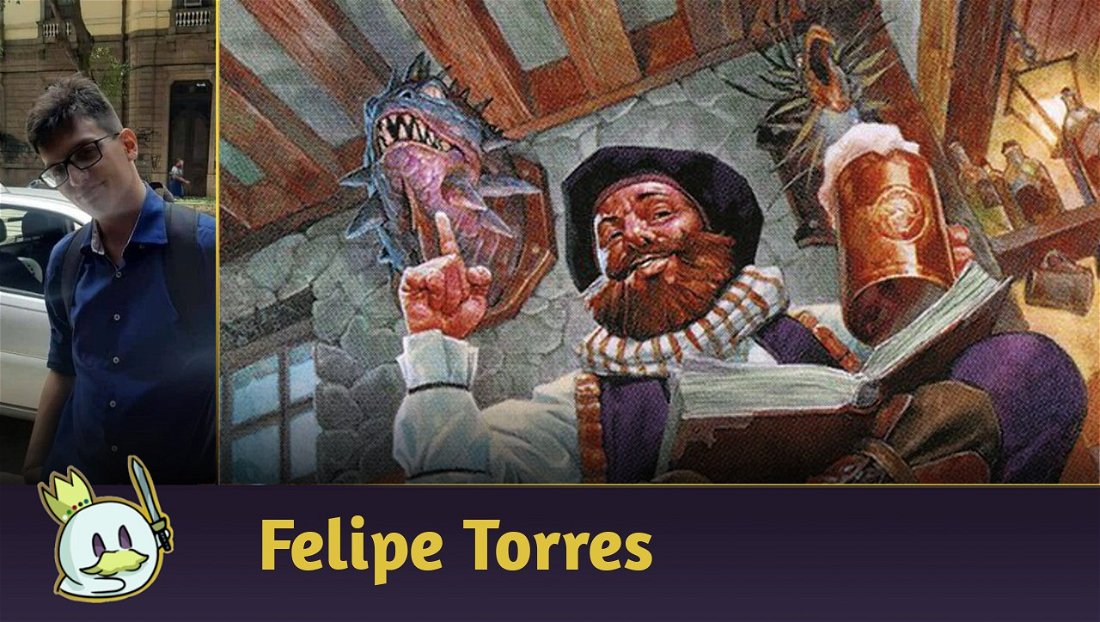Today we'll talk a little about the main decks that are seeing play on Standard, already thinking about the Arena Open.
At first, the format changed pretty much nothing with the addition of AFR, except that Sultai Ultimatum got even more popular, and we had a rise of Mono Green due to cards like Ranger Class and Werewolf Pack Leader. Mono Red is weakened by being naturally bad against Mono Green and doesn't handle Mono White very well, especially the combo version with The Book of Exalted Deeds.
Ad
Izzet Dragons also dropped a lot in the metagame as it is bad against Mono Green and Sultai adapted well against the deck. Even the non-snow version, with 4 new manlands and the addition of Burning Hands failed to make the deck more solid against the field. For the last tournaments carried out via MTG Arena and Magic Online challenges, we have Sultai as the most played deck and with more appearances in the top spots of tournaments with Mono Green a little behind, while the other archetypes occasionally showing up some results.
As the purpose of this article is not to discuss why the metagame is in this way (maybe we will do that in a future article), but to discuss the decklists of the main archetypes of the format and some that aren't currently on top tiers, but have potential.
Sultai Ultimatum
Starting with the most used deck, Sultai Ultimatum didn't have many changes with AFR because it didn't receive enough relevant cards to be tested. We have the addition of Iymrith, Desert Doom in place of an Elder Gargaroth in the main deck thanks to Burning Hands, the new removal for gigantic green creatures for two mana. This exchange has proven to be very fascinating, but not necessary. The dragon is good at matches with plenty of counterspells, although it takes Mystical Dispute, due to the card advantage it can generate by dealing combat damage. The blue manland, Hall of Storm Giants, is also another card that has proven to be good in the late game and I think it's a nice addition. Otherwise, the deck remains the same, only adapting the interactions to the metagame in with the usual cards.

A quick note on Iymrith: after a few more tests with Sultai, the blue dragon has been proving to be excellent against aggro as it's hard to use a removal on it thanks to the Ward 4 ability, forcing the aggressive decks to trade with the dragon or skip a turn to remove it from the board.
Mono-Green Stompy
The main rising deck, Mono Green, received some extremely relevant cards that are widely used. I'm talking about Ranger Class, Werewolf Pack Leader and Lair of the Hydra. This class is undoubtedly the best of the cycle, generating card advantage and board presence as soon as it enters the battlefield. Its level 2 is also excellent, taking creatures out of Heartless Act range and making any 1/1 a problematic threat in 2 or 3 turns; its last level is not always necessary, but when activated it usually wins the game by the huge advantage generated by the ability to cast creatures from the top of your deck.
The new manland ends up complementing the good threats against sweepers, as well as being a 1/1 creature for two mana for Lovestruck Beast to attack. However, when using the snow mana base, be careful not to end up with too many lands that don't activate Faceless Haven. The community is coming to the consensus that 2 or 3 non-snow mana lands with 3 Faceless Haven is an ideal combination for aggressive decks.
Ad
Mono Whites Combo & Aggro
Since we're talking about aggressive decks, let's look at the two versions of Mono White, the combo version with The Book of Exalted Deeds and the standard version. The combo deck turns out to be better in aggro matchups, as such decks usually don't have enough tricks to deal with the combo, while it gets worse against the most used deck of the format, Sultai because it's a slow and too reliant on Faceless Haven not taking a removal when activated to receive the counter that won't let you lose the game, or get stolen with the last chapter of Kiora Bests the Sea God.
Meanwhile, the standard version of Mono White is still good against Sultai, but a bit problematic against Mono Green, which can handle flying creatures and has Snakeskin Veil to protect its creatures from removal. The match against Mono Red is also balanced, although it tends a bit towards Mono White because cards like Reidane, God of the Worthy are absurd in the match, but nothing that an Embercleave cannot deal with. Another deck that has appeared frequently in tournaments (not necessarily doing good results) is Rakdos, which is naturally good against aggro as it has many removals and the Claim the Firstborn + Village Rites combo.
Izzet
Now let's go to other decks that are low in the metagame, but we know they exist and respect them with some slots on the sideboard and sometimes even on the main deck. Starting with Izzet, despite having received Burning Hands and Iymrith, Desert Doom, the deck suffers many problems against Mono Green and Mono White, if you use the snow-mana base. The deck was in the metagame previously to beat Sultai, and it's no longer efficient on that because even the new red removal isn't enough to contain Elder Gargaroth, Polukranos, Unchained and Koma, Cosmos Serpent.
[center(Grixis Treasures)
Derived from Izzet, a Treasure Grixis has emerged with focuses on dragons and new creatures that generate treasure tokens upon entering the battlefield or dying, accelerating Goldspan Dragon, Alrund's Epiphany, and Magma Opus to close the match.
Mono Red Aggro
Mono Red is still dangerous with Anax, Hardened in the Forge on 3 and Embercleave on 4, but that's basically it. We have some new cards that have been relevant to the deck, sometimes even turning the deck into a goblins tribal with Anax, Embercleave, and Bonecrusher Giant // Stomp as they are too good to be left out. Either way, both versions can't get past Mono Green's creatures and value generated by The Great Henge and Mono White, aggressive decks that are on the rise. Battle Cry Goblin tries to bring a new angle to the deck by being able to pump up other goblins, but it doesn't seem like enough to revive the deck before rotation as long as Mono Green is on the rise.
I even tried Zariel, Archduke of Avernus as a top-curver instead of Torbran, Thane of Red Fell, but it didn't seem like the best of options because it doesn't do much if you don't have a board with creatures and, in this scenario, normally the game is already won, and you only need one Embercleave to close the game. The deck's lower curve looks like a solution to rushing and playing under other decks, but it worsens matches against other aggro decks by taking away some of the deck's already scarce recursion.
Ad
Naya Winota
The last aggro deck of the article features an old acquaintance, Winota, Joiner of Forces. This time, the strategy seems a little more solid with Prosperous Innkeeper generating a treasure token to cast Winota on turn 3 and already trigger her ability, as the Innkeeper isn't a human. Minsc, Beloved Ranger is another card that brought some fresh air to the deck by generating a 1/1 non-human token upon entering the battlefield and having a great mana sink ability, pumping some creature to lethal.
Is the deck still a gigantic roulette to trigger Winota and win instantly? Yes, but a little more consistent to cast it on turn 3 and triggering at least twice.
Dimir Control
Moving on to the control side of the game, Dimir received great tools to overcome its greatest difficulty: closing the game.
Iymrith, Desert Doom and Hall of Storm Giants can lead the deck to victory quickly when the game is under control and are difficult cards to deal with. Another new card that fulfills this role is Ebondeath, Dracolich, but after some tests I exchanged the black dragon for a copy of Brazen Borrower // Pretty Theft in the main deck because the dragon always trades badly against Mono Green and dies to basically any red removal. Brazen Borrower is just as fragile, but at least it has the versatility to bounce some problematic permanent, generating some advantage in the game with its presence.
The Power Word Kill removal is pretty interesting, as it's only bad against Izzet and Faceless Haven. As such, its addition to the sideboard is quite valid against any aggro deck in place of Feed the Swarm that is on the sideboard to deal with Roiling Vortex and other troublesome enchantments. Even swapping a Brazen Borrower for another copy of the new removal is an alternative.
Temur Lukka
The last deck for today is Temur Lukka which is on the rise. I don't particularly like this archetype because it's a deck that almost always wins when it has 5 creatures from Eldraine on the top 15 cards or loses if it only has 2 or 3 Eldraine creatures on 15 cards. However, the deck is on the rise as it has an even match against Sultai and Mono Green, with the only addition of AFR being the red removal for green creatures.
Conclusion
Finally, I'm going to talk a little about which decks I think are the best in the format – a kind of informal tierlist.
Sultai is still the best deck of the format, even with few additions, but they were very punctual and cover some angles that left something to be desired or that facilitate closing of the game. Mono Green and Temur Lukka appear right after this week (article written between July 21-23) for their ability to deal with aggressive decks and have even matchup against Sultai. Some Rakdos have been used, but they simply can't beat Sultai and even Mono Green manages to win with some ease. Dimir Control has a lot of potential, but I feel that it lacks some more finishers and cards against Mono Green, some adjustments that make the deck more solid in crucial turns, and I think this is possible with a little more tinkering on the archetype.
Ad
Both versions of Mono White look good, but have restrictions on how much of the field the deck intends to focus on. Meanwhile, the Naya Winota has been growing thanks to the AFR creatures that have given more consistency to the deck, but it's not yet known how consistent it is or whether it's enough to stay in the format. The rest of the decks seem to be far from those mentioned above, and I don't recommend it.
That's it for today. I hope the deck lists and explanations were helpful. It's important to note that so far there haven't been many relevant tournaments to the format, so the lists will definitely change in the future.
Thank you for reading!








— Comments0
Be the first to comment